This post have been revised and republished with a new description of .308 included. We wish to thank to our readers for noticing the error and reporting it.
When SHTF and security is a concern, the best firearm is the one you have with you–so long as its loaded and you know how to use it. While that notion holds true if disaster were to strike tomorrow, you have time to consider the logistics of your firearms preparation before a threat becomes imminent.
To that end, some ammunition is considered more viable and effective for survival use than others, though specifically can be considered the best. In a survival scenario, availability is key when it comes to weapons and ammunition selection.
Thus, the following five types of ammunition have been selected primarily for their high availability in normal times, which is likely to linger on when SHTF.
1. .22LR
The .22 caliber Long Rifle rimfire cartridge is commonly considered the best all-around survival 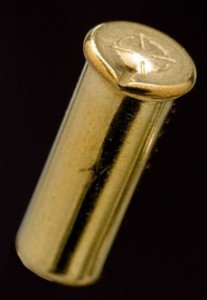 ammunition. The rounds are produced by nearly every ammunition manufacturer and are available for most makes and models of both .22 caliber pistols and rifles.
ammunition. The rounds are produced by nearly every ammunition manufacturer and are available for most makes and models of both .22 caliber pistols and rifles.
The generic 40-grain high velocity round can be found for a dime a dozen, while more powerful rounds are also tailor-made for mid-sized game hunting, self-defense, and competition shooting.
Its availability, variety, and affordability are what make the .22LR round a must-have for long-term disaster survival, when other variants of ammo may become a scarce and expensive commodity. Accordingly, .22LR cartridges are lightweight enough to carry 1,000 rounds (or more) in the event you have to bug out.
Hunting for your own food becomes a necessity when your stores run dry in the aftermath of a crisis. Fortunately, the .22LR is among the most trusty ammo for small-game hunting, whether chambered through a bolt-action, lever-action, single-shot, or semi-automatic rifle. Long-barreled .22 caliber pistols may also be serviceable for small-game hunting with the right variety of cartridge in the right conditions.
As a relatively small round, the .22 is not the best self-defense ammunition, but when SHTF you have to use what you have to defend what’s yours. If you stock up on high-performance rounds, your abundance of ammo will at least give you a numbers advantage when it comes to disposable ammunition against a potential threat.
2. 12-gauge
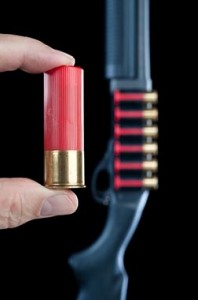 Though many say the .22LR is the ultimate survival round, a large portion of the prepping community agree that the shotgun is the ultimate survival weapon. To that end, the 12-gauge shotgun shell deserves a spot in any survival defense system.
Though many say the .22LR is the ultimate survival round, a large portion of the prepping community agree that the shotgun is the ultimate survival weapon. To that end, the 12-gauge shotgun shell deserves a spot in any survival defense system.
Though some brands produced for specific shooting purposes can be pricey, generic 12-gauge rounds are relatively inexpensive and widely available.
When it comes to efficient ammo consumption, most people prefer pump-action shotguns to the often complicated and slower-loading semi-automatic.
12-gauge shotguns have been a staple for hunters of both four-legged and flying game for decades, and have thus proved their practicality for use in a survival situation. Bird shot shells will take down most flying fowl and small game, while buckshot and slug shells can be used against deer and other bigger game.
12-gauge shotguns are also widely carried by members of the law enforcement and military communities, as they are among the most formidable firearm in close-quarter scenarios. When loaded with buckshot, a 12-gauge can mow down pretty much any target within 10-yards, while slug rounds will extend the shotgun’s range and accuracy.
3. 9mm
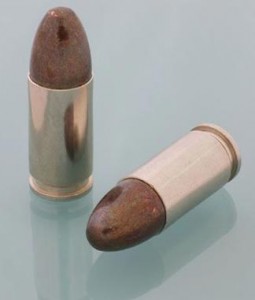 The 9mm is easily the mostly widely used pistol round in the world. There has been a longstanding debate between the 9mm and .45 caliber as to which makes the better pistol round, but ultimately its up to personal preference.
The 9mm is easily the mostly widely used pistol round in the world. There has been a longstanding debate between the 9mm and .45 caliber as to which makes the better pistol round, but ultimately its up to personal preference.
However, if we’re going on availability alone, the 9mm wins the race when it comes to long-term supply in a post-disaster survival situation.
Like the .22 rimfire, there are a lot of options to choose from when it comes to 9mm rounds. 115-grain FMJ and 124-grain NATO rounds will likely remain the most readily available and inexpensive in the dawn and aftermath of a disaster, and both are favored for their reliability when loaded in older-model pistols and submachine guns.
Though most often found in handguns, there are some pistol-caliber carbine rifles that employ the use of 9mm rounds. While a pistol is a must have in any layered defense, a 9mm carabine rifle provides an additional platform for your 9mm rounds to be used for more effective self-defense.
Accordingly, they’ll do just as much justice as the best .22LR against small game for emergency hunting use.
4. 5.56 NATO
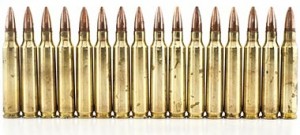 As the primary round issued to American military servicemen and women, no prepper should be without a rifle or carabine that fires the 5.56x45mm NATO round.
As the primary round issued to American military servicemen and women, no prepper should be without a rifle or carabine that fires the 5.56x45mm NATO round.
The fact that weapons factories, military installations, National Guard stations, and thousands of residential homes are currently filled with 5.56 rounds, there isn’t likely to be a shortage on availability any time soon.
The 5.56 NATO has been field-tested and battle-approved to be a highly effective anti-personnel round at a range of about 300-meters, depending of the barrel length of the gun.
When it comes to post-disaster survival, 300-meters is quite a distance to attempt hitting any target, human or animal. While you’ll find some relief in knowing you’ll have your perimeter covered, your efforts should be focused on designating targets within 100-meters, both for hunting and self-defense. Though advanced optics will improve your accuracy, a military-style 5.56 rifle with basic iron sights can easily take down a buck at a moderate range in the hands of a steady shooter.
Overall, you know you’ve got your hands on a reliable and versatile round in the same ammunition used by the most formidable military in the world.
5. .308
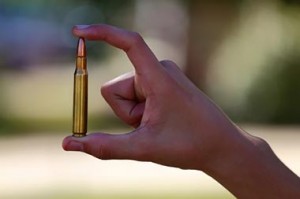 The .308 Winchester–a shortened version of the .30-06–is a great alternative to the .22LR and 5.56, a jacketed version of the .22, for hunting and all-around survival purposes. .308 rounds are available in weights between 147 and 180 grains and offer significantly more muzzle velocity and stopping power than .22 and .223 rounds.
The .308 Winchester–a shortened version of the .30-06–is a great alternative to the .22LR and 5.56, a jacketed version of the .22, for hunting and all-around survival purposes. .308 rounds are available in weights between 147 and 180 grains and offer significantly more muzzle velocity and stopping power than .22 and .223 rounds.
The .308 Winchester is essentially a civilian version of the 7.62x51mm NATO round, though the two are not identical and the rounds are not always interchangeable.
The .308 has a reputation for reliable accuracy, and thus has long been favored by competition rifle shooters, in addition to a plethora of hunters.
From a 24-inch barrel, .308s have an effective range of about 800-yards. Though they would be on the small side for the largest of North American game like moose and brown bear, which would be best hunted using .300 Magnum rounds, .308 Winchesters are suited for hunting most big game from bucks to bobcats.
Most AR10–and some AR15–platform rifles chamber .308 Winchester rounds, making them equally suitable for defense purposes. Though the recent ammo shortage scares have many concerned over the future availability of rifle ammunition, .308 rounds seem to have promising odds for the long-term. As a commonly used sporting and military rifle/carbine round, .308s are manufactured by dozens of North American and European companies alike.
Though you may prefer a grade of ammo not mentioned above, keep in mind that you will likely have to pay more to stock more in normal times and look harder to maintain your stores when SHTF. Because they are already so widely used in the law enforcement, military, hunting, competition, and recreational shooting communities, the five types of ammo mentioned above are considered to be incredibly useful and versatile selections for disaster survival.
Regardless of your favorite(s), make sure you store and rotate your ammo appropriately to maintain its effectiveness and keep your shooting skills sharp.
by Cody Griffin

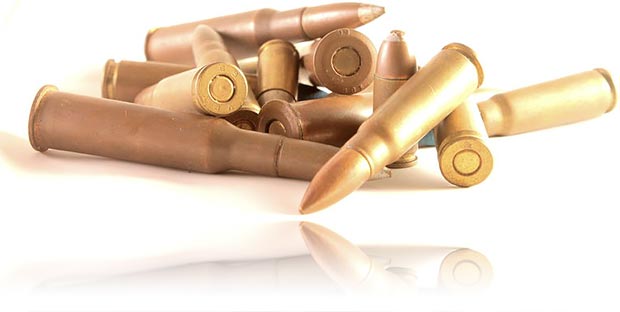





762×39? Cheap found everywhere and powerful